It’s been a year since we released Prusament PC Blend so we thought it was a great time to introduce a new member to the PC Blend family. Here comes the Prusament PC Blend Carbon Fiber! Thanks to its great mechanical and temperature resistance, it works amazingly well for printing various engineering components. Let’s have a look at its best qualities.
Specification
PCCF (Prusament PC Blend Carbon Fiber) has similar printing qualities to unmodified PC Blend but the addition of the carbon fibers makes it even stronger, more resilient, more temperature resistant, and dimensionally stable. Compared to other materials, PCCF has good resistance to UV light and common chemicals.
PCCF is slightly lighter than unmodified PC Blend, with approximately a 5% difference. Carbon fibers inside the filament are made by recycling waste from the carbon fiber composite manufacturing process or from carbon composites after the end of their lifespan. PCCF is ideal for printing mechanical parts and heat-stressed components, for example, gears and machine parts requiring heat resistance over 100°C.
Probably the greatest advantage of PCCF, compared to PC Blend, is the possibility of printing large models without the necessity of using an enclosure due to it’s extremely low warp, even less than its PC Blend sibling. For those looking for a matte finish, PCCF will find a welcome home.
Broken PCCF test object with visible carbon fibers seen under the electron microscope
Like any other material, PCCF also comes with few downsides. The main disadvantage is the necessity of using a hardened steel nozzle. Carbon fibers are highly abrasive material and may damage a brass nozzle. Another disadvantage is that the filament is more prone to breaking (i.e. lower charpy impact toughness).
The third disadvantage is the slightly higher price per kilogram of material, due to a more difficult manufacturing process we sell PCCF for a higher price than the unmodified PC Blend, with 800 grams of filament on a spool. However, due to the lower density of the filament, you’ll still get slightly more filament than you’d get with 800 grams of unmodified PC Blend.
Pros and cons
| Pros | |
|---|---|
| Great mechanical properties (strong and resilient) | |
| High heat deflection temperature (114 °C) | |
| Easy annealing (increases the HDT to 130 °C) | |
| Dimensional stability – easy to print large models | |
| High wear resistance | |
| Good resistance to UV light and common solvents | |
| Nice, professionally-looking matte surface | |
| Lighter than pure Prusament PC Blend | |
| The enclosure is not needed | |
| No need for drying prior to printing | |
| Reusing recycled carbon fibers taken from the manufacturing process | |
| Cons | |
|---|---|
| The necessity of using a hardened steel nozzle (highly abrasive) | |
| Lower impact resistance compared to the pure Prusament PC Blend | |
| Higher price | |
| Lower precision tolerance (0.04 mm) | |
Keep in mind that the stated precision of the PCCF filament thickness is slightly lower – this is because the filament strand is rough due to the carbon fibers embeded in it. However, due to the homogenous surface, the overall filament volume remains as precise as possible.
Color and price
Similar to the legendary Ford Model T, you can have Prusament PC Blend Carbon Fiber in any color, as long as it’s black 🙂 However, we think the matte black finish (i.e. natural look of the carbon fibers in the filament) results in an extraordinary, professional appearance which more than makes up for the lack of color choice.
We sell one 800g spool of Prusament PC Blend Carbon Fiber for 59.99 USD / 59.99 EUR (VAT incl.). The price per kilogram is therefore higher, but as mentioned above, thanks to the lower density of PCCF you’ll get slightly longer filament than with the same weight of PC Blend.
Print with hardened nozzles
The biggest disadvantage – and yet more like an inconvenience rather than a real disadvantage – is the necessity of printing with a hardened nozzle. If you haven’t used any abrasive materials yet, don’t forget to buy a hardened steel nozzle with your PCCF spool. Regular brass nozzles might wear out and cause trouble in the future.
Print surface preparation
The material name gives a hint on how to treat it – it’s Prusament PC Blend enriched with carbon fibers. This means that print surface preparation is similar to the unmodified PC Blend: When printing on the smooth PEI sheet, ALWAYS use a glue stick to prevent any damage. Unlike Prusament PC Blend, PCCF doesn’t need a separation layer (glue stick) for our classic Powder-coated and Satin sheets.
Protip: Do you need to add the Prusament PC Blend Carbon Fiber print profile into PrusaSlicer? Make sure you’re running PrusaSlicer 2.3.1 or newer. Go to Configuration – Configuration Wizard – Filaments – PC – Prusa Polymers – check the Prusament PC Blend Carbon Fiber option and press Finish. Now, PCCF will be available in the list of materials.
PCCF annealing
As we mentioned above, Prusament PC Blend Carbon Fiber excels in its heat resistance. With its 114 °C Heat Deflection Temperature right after printing, it is by far the best of our supported filaments. That’s not all, an even higher temperature resistance can be achieved with annealing. If done correctly, it can improve PCCF temperature resistance up to 130 °C! Even better, thanks to the added carbon fibers, annealing results in an almost negligible amount of shrinkage. We’re talking about one percent! The whole process is pretty simple, too:
- Print your model with PCCF PrusaSlicer profile
- Preheat the oven to 140 °C
- Put the model inside the oven for 120 minutes
- Pull the model out and let it cool down to room temperature
Typical applications for Prusament PC Blend Carbon Fiber
If you want to know more about print settings and the mechanical properties of our Prusament PC Blend Carbon Fiber, don’t forget to have a look at our materials table. We believe that the Prusament PC Blend Carbon Fiber will suit your engineering needs and we are looking forward to seeing all your amazing ideas and original 3D models.
Happy Printing!






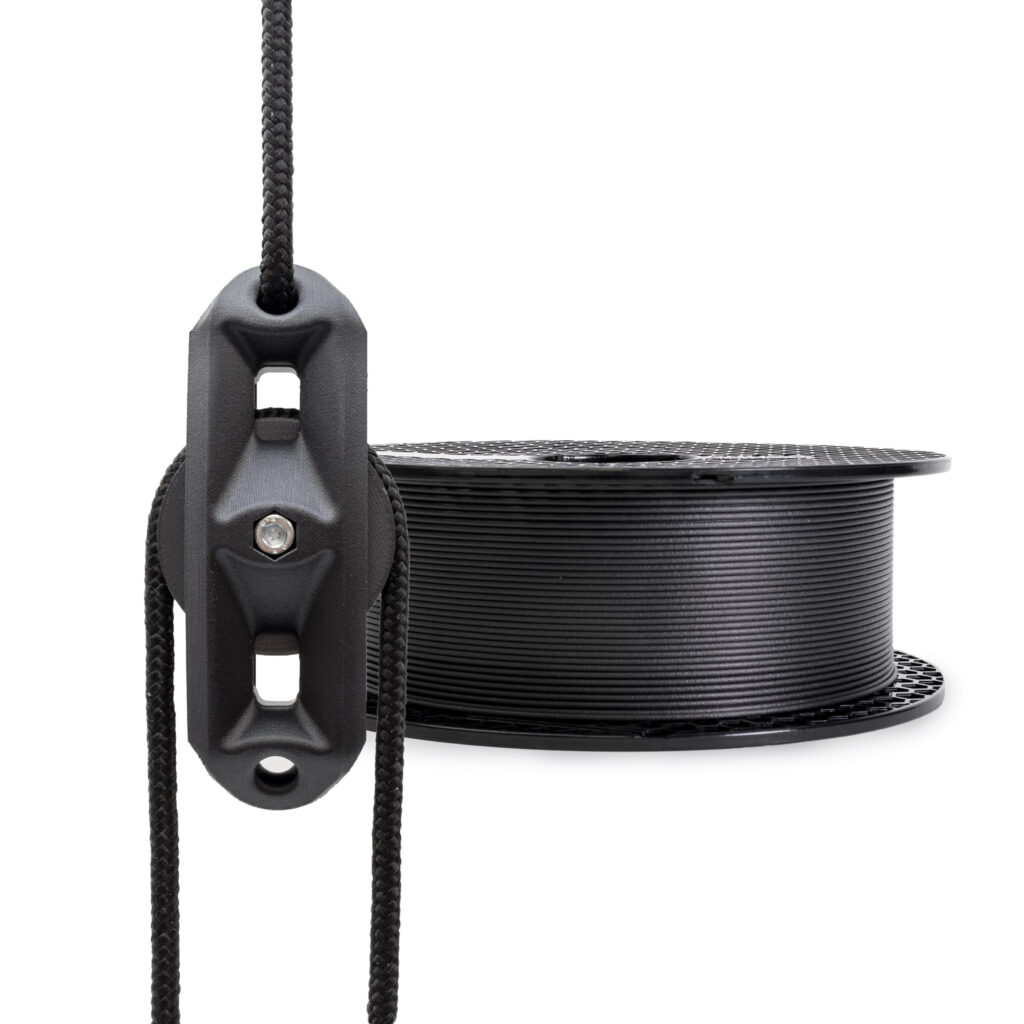

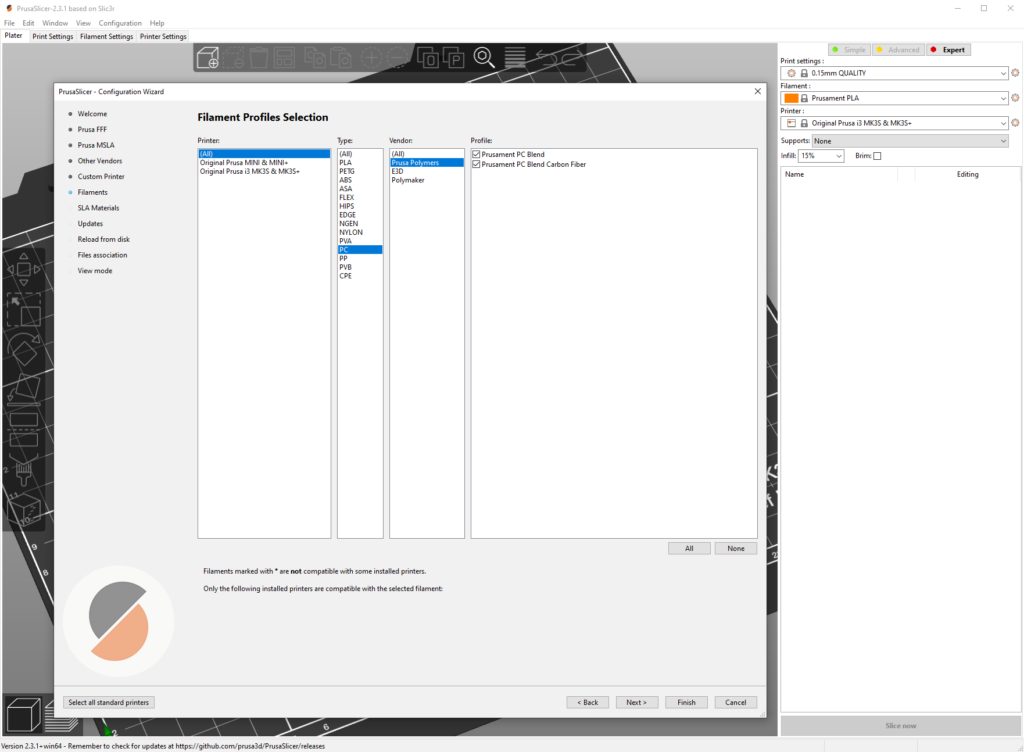
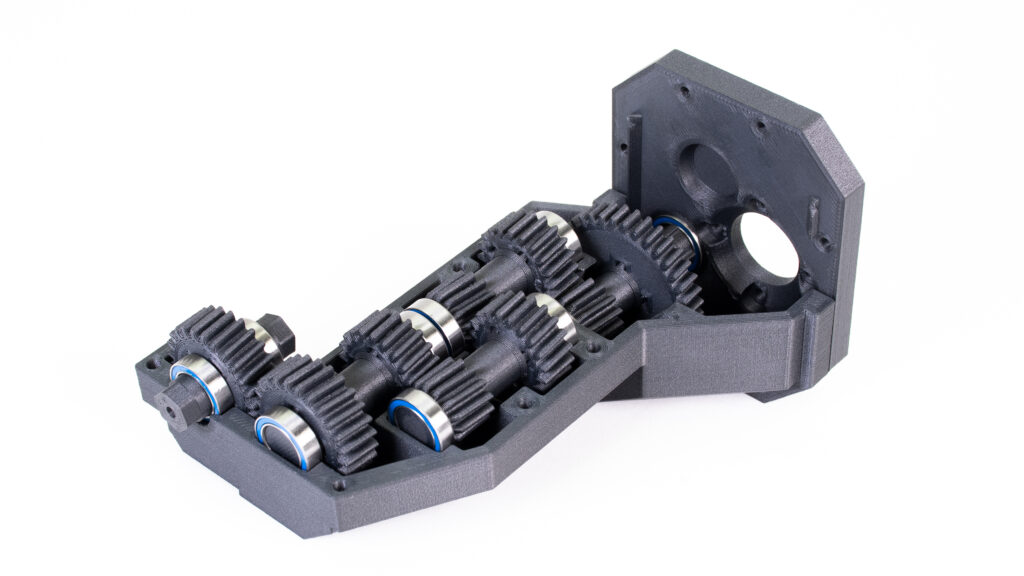
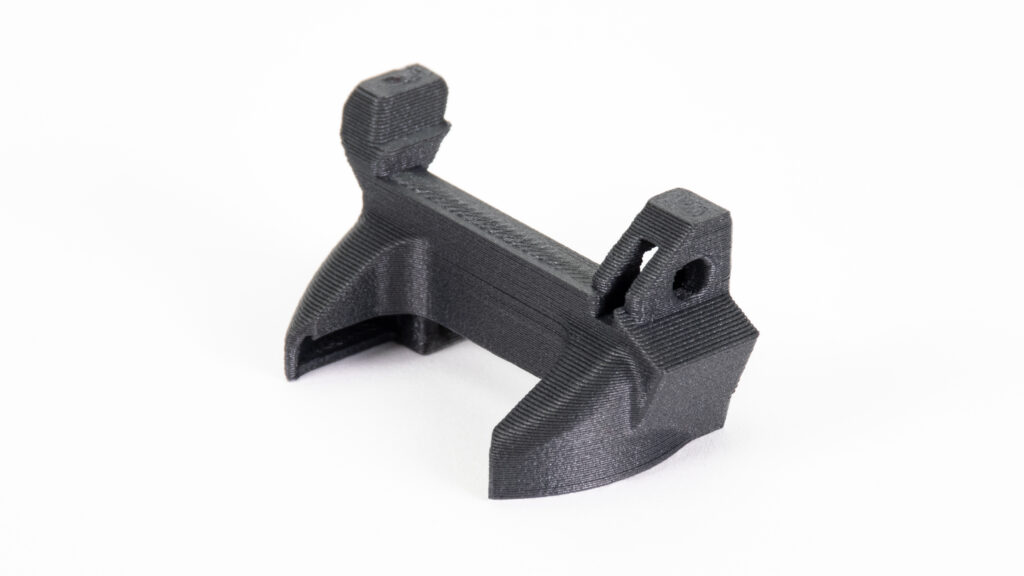
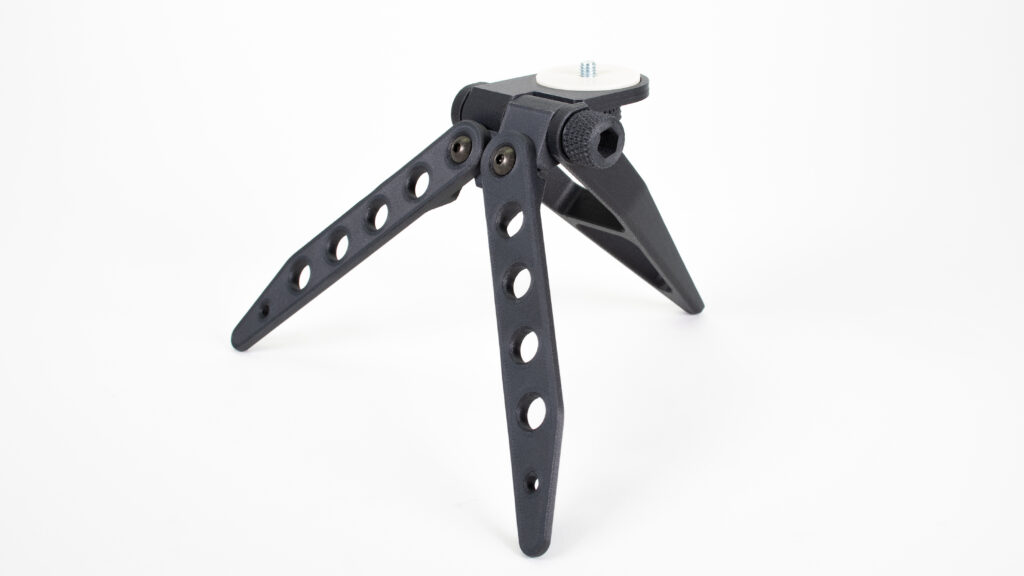
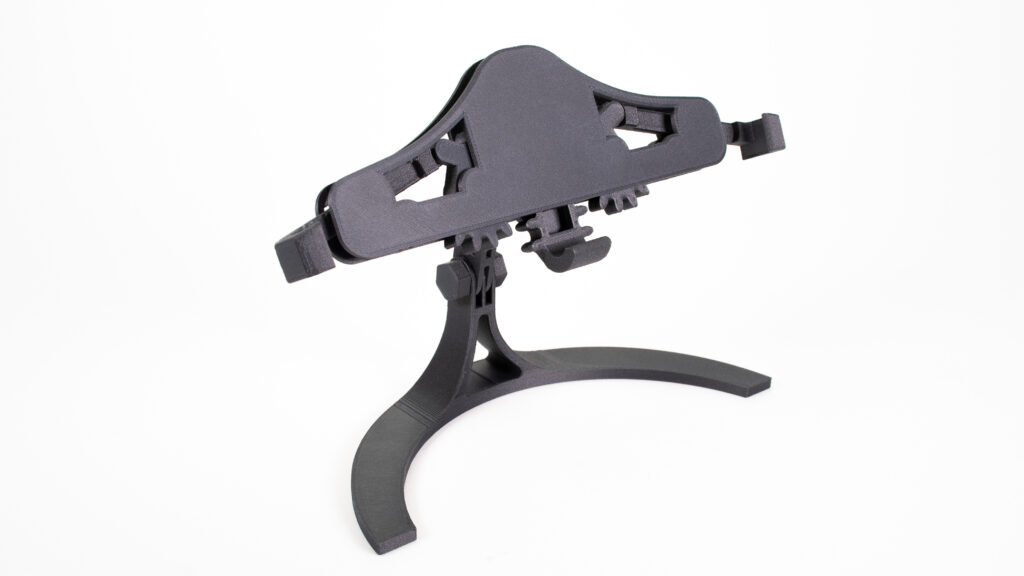
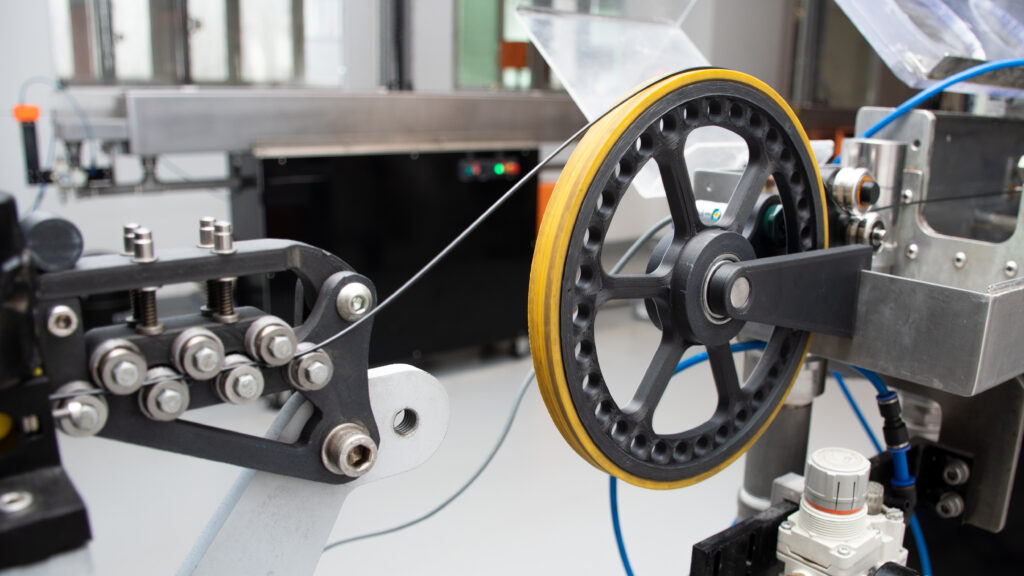
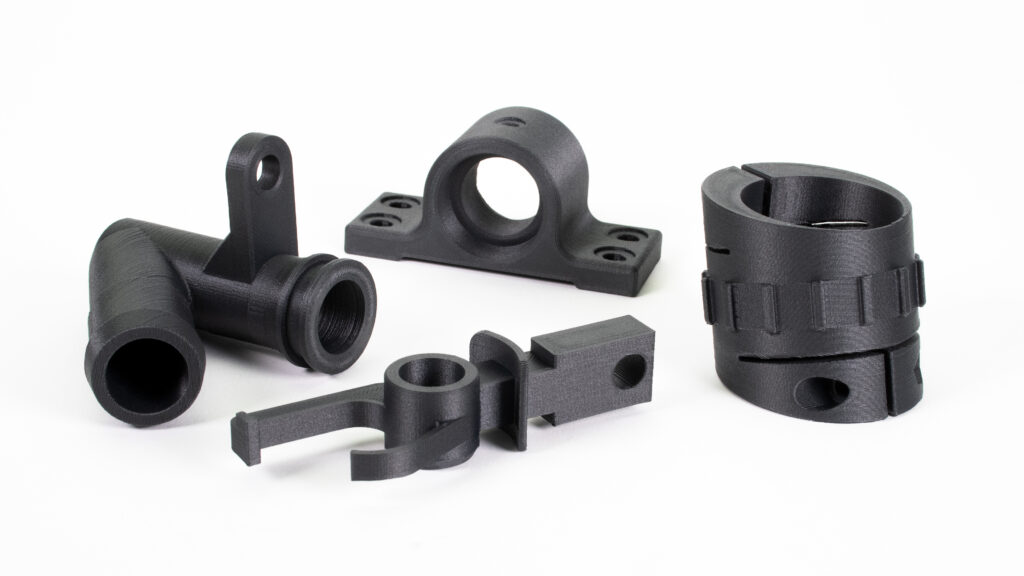
Hey ! Any health advices for it ? Can we print it in an enclosed area, can it be dangerous for our health if it burns up ? Would be much appreciated guidelines. Thanks !
Hello,
generally spoken, every filament should be printed in a properly ventilated place. But the odor of the PC Blend Carbon Fiber is very low (compared to ASA for example). You can find out more in the material safety datasheet: https://prusament.com/media/2021/06/PCB_CF_MSDS_EN.pdf
How stiff is this compared to PLA?
Hello, PC Blend Carbon fiber has every attribute better than PLA, even stiffness. It’s very hard to bend and break, it resists well in the yield tension and it has much better resistance to wear and heat.
Hello, is the Phone mount a new type of demo print from prusa ? Or is it an existing model on PrusaPrinters ?
Hello, it’s a model from Thingiverse:
https://www.thingiverse.com/thing:3681512
Wow, that phone stand looks really different in a black matte. I like.
Hi,
I’m really curious to try this new filament out.
Does it release any toxic fumes when printing?
Hello, there is a small amount of fumes with carbon particles released during the print. The number of particles is really small, but we recommend printing in an enclosure or a well-ventilated room, to keep it as safe as possible.
Is it a suitable material for the Prusa Mini?
Yes, it works with Prusa MINI too.
You say it is compatible with the mini, but according to the filament specs you need to print at 285/110 °C and the mini can only do 280/100°C. Does that mean it needs to be printed slower or might cause issues?
But it’s not in the materials table 😅
Are you sure? 🙂 Look at the Composite materials.
Hi Prusa,
Your datasheets state the PCCF its stiffer and easier to print than PC blend – which is great and delivers already very good value! Thanks for that nearly perfect material!
But I am wondering about the strength and toughness values in the datasheets – both Charpy and tensile strength show lower values in PCCF compared to normal PC blend. However you are advertising this new material as “stronger, tougher and more resilient”.
See here:
“Prusament PC Blend Carbon Fiber (PCCF) is a PC Blend filled with carbon fibers to improve its strength, toughness and temperature resistance. ” from the shop site: https://shop.prusa3d.com/en/prusament/1576-prusament-pc-blend-carbon-fiber-black-800g.html#_ga=2.229038172.1978836394.1623222790-1919360714.1623222790
Can you please elaborate on the discrepancy of datasheet vs advertisement? What do you mean with “stronger”, “tougher”, “resilient”?
…anyway: All Carbon fibre materials seem to loose tensile strength and impact resistance compared to the non-fibre variants… most known example is probably the colorfabb XT CF 20, which (corresponding to your material database) also has less impact resistance and tensile strength than the pure XT. On the other hand, these materials gain stiffness and dimensional stability. However, i am wondering why more or less all manufacturers advertise their fibre-products with “tougher, stronger, more resilient, …”
I really appreciate you are providing datasheets for PRINTED parts, which is not done by most companies – other datasheets therefore are showing a big difference between theory and practice – which also can be seen in your – unique and very valuable – material database!
(That one: https://help.prusa3d.com/en/materials .. hint: compare colorfabb XT with XT CF20, and PC blend vs PCCF… and than search for XTCF20 datasheet (states much higher values)…)
Hello, one of my colleagues told me that you posted this comment And hot no reply. I’m sorry for the trouble, the post for some reason needed to be approved and I didn’t see it. I didn’t mean to ignore you. 🙂 Anyway, I’ll do my best to answer your questions once I get to my computer (tommorow morning).
You are right that the Impact charpy resistance is lower than with the pure PC Blend. And we state that pretty clearly on our Blog and Prusament site. The sentence from our shop got somehow lost in translation. However, conserning the tensile yield strength, in the vertically printed XZ values, PCCF is actually slightly better than PC Blend. And – for the record – this value is the one we tested and compared for all filaments in our material table.
About saying that material is stronger and more resilient: It is very stiff, hard to bend and prone to wear. The only discrepancy i see there is the mentioned toughness on our eshop.
Hey Jakub, thanks for the explanation. I have 2 questions about PCCF.
1. If I’m printing a rotor for a brushless engine for my drone project, it will face high relative centrifugal force, mostly caused by neodymium magnets and a propeller. What is a better choice then: PC blend or PCCF? In the original version, PETG was used, but I wanna try the PC version instead. As this is a constant force and not a hit impact basically then stiffness should be more important in my case (or am I wrong?). About resilience – is this word used as a scientific term? If so, then it is a synonym for “elastic”, but carbon-filled filaments are always more brittle compared to non-filled ones, according to my knowledge. So this term is a bit misleading for me.
2. And if I would like to anneal it after printing, should I scale +1% to model size in the slicer, even if I have 100% infill? Will annealing further improve the tensile strength of PCCF?
I’m thinking of trying this filament for the extruder now that have and excuse to let my annealed HTPLA-CF experiment finish. When I first put my annealed HTPLA-CF (ProtoPasta’s forumla) together I was really hopeful. The parts had really good surface hardness and parts (specifically the filament sensor arm) slid easily against each other. I used ProtoPasta’s published scaling factors and after annealing all my dimensions were close enough so screw holes lined up properly, even the ones across multiple parts. The one thing that I noticed right away that gave me a little pause is because of the surface hardness the E3D heatsink turned easier, but that hasn’t been a problem. Where I eventually had issues was layer adhesion in high-stress areas. Specifically the fan end of the print fan mount split where the hex nut was press fit in. And, the PINDA mount eventually failed, breaking in two places, across layer lines. I’ve been limping along with my MK3S extruder assembly in the HTPLA-CF, occasionally needing to re-adjust the PINDA because the broken mount only mostly holds it.
Now I finally got my MK3S+ upgrade kit and I have the perfect opportunity to try out the new PCCF filament for all my extruder parts. (Yes, I’ll probably print all the parts, not just the ones required for the S to S+ upgrade just so the entire assembly has the same surface finish. Sometimes being a slave to aesthetics can be a bitch…) 😉 But I have some specific questions:
1. How is the layer adhesion, especially in applications like the PINDA holder where a little flex is needed?
2. What, to 0.1%, should be my scaling correction should I decide to anneal the parts to get a result with the correct geometry? Is it the same across all three axes, or like in ProtoPasta’s blog (see link below) the scaling was different along the z (the sample grew) than the x and the y (the sample shrank). I ended up printing those parts scaled at 100.6% in x and y, and 99.0% in the z and I got acceptable results. Yes, I know, odd geometries (like the extruder parts) can make the change in size tricky to predict, but the CF seems to have done its job and reduced warping.
3. If I choose to anneal would that make the part stiffer, potentially allowing similar damage to what I experienced with the annealed HTPLA-CF?
I would be testing some of these things myself (or in a few days) but I missed the first batch of PCCF. :-/
https://www.proto-pasta.com/blogs/how-to/heat-treating-carbon-fiber-htpla-for-accurate-heat-resistant-parts
Hello,
1) The layer adhesion is worse than the Prusament PC Blend has. We suggest printing with higher temperatures (PrusaSlicer Profile is set to 285 °C but I suggest 290 °C) and without print cooling. Printing in an enclosure might also significantly increase the layer adhesion.
2) The shrinkage was under 1% in all dimensions, but it is for information purpose only. First, you should print some testing object, anneal it with your equipment and then try it with the scaled model you need to have annealed.
3) Unfortunatelly, annealing improves significantly only the heat deflection temperature. Other values stay more or less the same, within standard measurement deviation.
Hi
If I heat treat my prints so that the heat deflection temperature increases to 130C would it be possible to autoclave the material ? ( 121 C , high pressure, 100% water humidity )
Looks to be the perfect material for the use in a laboratory!
Kind regards
Hello, it might work but I personally wouldn’t count on a long lifespan under these conditions.
Also, it shouldn’t be stressed with too much weight on it, the 130 °C resistance applies for 0.45 MPa stress. When stressed with 1.8 MPa, the heat deflection temperature is 119.4 °C.
What’s the creep resistance of this material in ambient conditions?
I’m afraid we haven’t tested this value. The only heat resistance we tested is heat deflection temperature for 0.45 MPa and 1.8 MPa.
This is great material… Just be careful of using the smooth sheets! Since the temperature will lift the PEI.
https://www.prusaprinters.org/group/extreme-printing-15DBBbZ
When is it expected to be back in stock?
What’s the new size of the extended base ‘how much space do you need on table top)?
Do you intend to make CF versions of other Prusament materials? CF PETG for instance. If so, any expected timeline?
good share.
what is the pulley model you have pictured with the filament? it’s different than the original pc-blend model. thanks
Hello, you can find it here: https://www.prusaprinters.org/prints/73671-pc-blend-carbon-fiber-prusa-pulley
Hi – Im very glad to have been able to order a roll of this filament recently. I have studied the information provided here and on the materials table and I have two quick questions which might help my experience printing:
– I only have a 0.35mm E3D hardened steel nozzle, is that diameter likely to cause clogging due to carbon particles, etc (such as with wood filaments) or could that be OK?
– My printer has a glass “ultrabase” style print bed (glass, with textured ‘dots’). Do you have any basic advice as to how to prep printing?
Many thanks
I bought two rolls of the Prusament PC Blend Carbon Fiber and so far, I’m impressed. I don’t see it in the store anymore. Has it been discontinued?
Hi, can I use PCBC for the outer perimeters and normal PC blend for the infill? And what is a suitable support material?
you could try ASA for supports (you will need to use the MMU), which is what prusa suggested to me. I have not yet tried it.
When it will return in stock?
Thanks
The PCCF filament seems like a wonderful material, but there is one serious drawback that I unfortunately did not learn about until after I had bought a roll and started printing with it. I wish it had been emphasized in this article and in the webstore listing that PCCF filament is NOT compatible with the Prusa MINI/MINI+. As I learned, the filament will jam in the Bowden tube and cause serious problems. I haven’t yet had a second response from Prusa help, but this is what I wrote to them in hopes of saving others from making my mistake:
“Thank you very much for the fast and helpful information! I will immediately stop using PCCF filament on my MINI+ and inspect everything for any damage that may have been caused.”
“I have one last comment/suggestion. As I mentioned in my original message, I’ve been using my MINI+ for the past year with great success. However I never noticed before the fact that MINI+ is not compatible with Carbon filled filament. Before buying the Prusament PCCF filament and hardened nozzle, I carefully read everything I could find in the Prusa Knowledge Base and blog about this material, so that I would understand how to use it. In particular, I carefully read the June 9, 2021 article by Jakub Koči about PCCF. It has much useful information about the material’s applications and pros and cons, but it doesn’t make any mention of being incompatible with the MINI+. Similarly, the Prusament product information page for PC Blend Carbon Fiber Black does not mention this incompatibility, even though there is a lot of good information there about its attributes and use. I know the mistake is ultimately on me, but may I suggest that you add some warning information to your articles and web pages? I think it might help others avoid making an expensive mistake like I did. Thanks.”
Which soluble filament works best with PCCF?
I am interested in printing the tripod that is displayed as part of the article. Could you point me in the right direction of where that stl is located?
Thank you
Great filament, however, I’m having issues with overhangs. Any recommendations on that?
I am interested in the topic you mentioned. I also enjoy playing Vampire Survivors in my spare time.